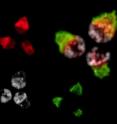Live-action films of worm sperm help researchers track critical fertility enzymes
Compared to most other cells in an organism, sperm undergo a radical transformation to become compact and mobile delivery systems for paternal DNA. Even though sperm looks and moves quite differently across species, SF State researcher Diana Chu and colleagues now say that there are at least a few key enzymes that are critical for sperm development and mobility in species as different as mice and nematode worms. The study by Chu, et al., was published online in the journal Genetics.
These enzymes (called PP1 phosphatases) are multitaskers in the nematode, which Chu and the others discovered through unique live-action films of the enzymes at work. First, the enzymes help to separate chromosomes during sperm cell division. After that, they play a role in the development of the sperm's pseudopods -- the appendages that nematode sperm use to move. Pseudopods propel the sperm with a "treadmilling" motion, and the enzymes help disassemble the cell's inner skeleton in a way that pushes the treadmilling forward.
Sperm in mammals like mice -- and men -- don't have pseudopods and don't move in the same way, but they still rely on the phosphatases for development and mobility. Further study of the phosphatases could someday shed light on some of the causes of human infertility, since the enzymes seem to be critical for sperm function.



